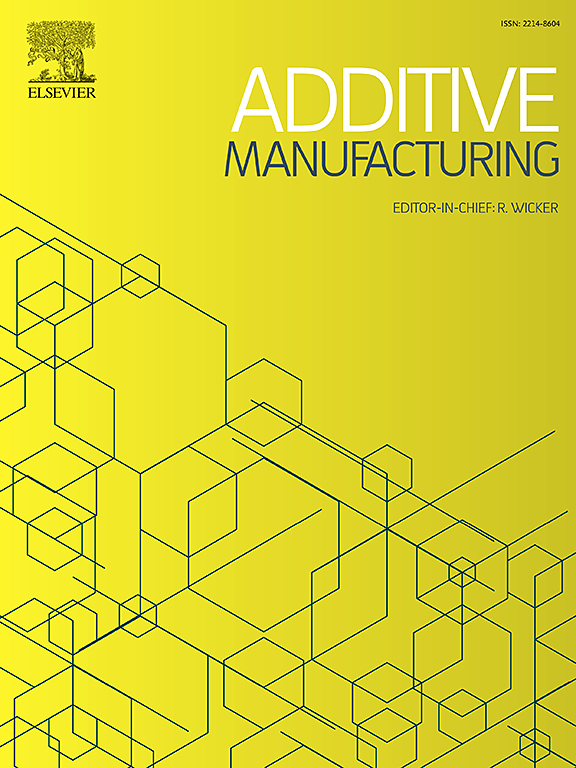Impact of oxygen inhibition on (meth)acrylate photopolymerization in tomographic volumetric printing
IF 10.3
1区 工程技术
Q1 ENGINEERING, MANUFACTURING
引用次数: 0
Abstract
Oxygen inhibition in (meth)acrylate photopolymerization gives rise to a gelation threshold by delaying polymerization until the accumulated light dose exceeds a critical value, thereby enabling 3D printing with tomographic volumetric additive manufacturing (TVAM). While this thresholding behavior is essential to TVAM, its underlying kinetics have not been thoroughly studied. In this work, we systematically examine how photoinitiator (PI) concentration and light intensity govern the time required to deplete oxygen in (meth)acrylate photoresins, and evaluate their impact on print quality. To investigate these effects, we derive theoretical results elucidating oxygen inhibition, which remain valid even at low PI concentrations typical in TVAM printing, and can be used to estimate the oxygen concentration in the photoresins. We compare these predictions with photo-rheology experiments and observe good agreement. The findings reveal that at low PI concentrations, decreasing PI concentration dramatically increases oxygen depletion times, thereby extending oxygen diffusion periods and leading to poor printing quality; a similar trend is observed with reduced light intensity. While higher PI concentrations and increased light intensity can improve print quality, they are constrained by penetration depth limits and illumination restrictions of LED-based projection sources. This study also highlights the challenges of printing larger parts in TVAM, where oxygen inhibition and limited light penetration narrow the usable PI concentration range. These insights help optimize TVAM parameters to improve print quality and expand the technology's capabilities.
氧抑制对层析体积印刷(甲基)丙烯酸酯光聚合的影响
氧抑制在(甲基)丙烯酸酯光聚合过程中,通过延迟聚合产生凝胶阈值,直到累积光剂量超过临界值,从而使3D打印具有层析体积增材制造(TVAM)。虽然这种阈值行为对TVAM至关重要,但其潜在的动力学尚未得到彻底研究。在这项工作中,我们系统地研究了光引发剂(PI)浓度和光强度如何影响(甲基)丙烯酸酯光树脂中耗氧所需的时间,并评估了它们对印刷质量的影响。为了研究这些影响,我们得出了理论结果,阐明了氧抑制作用,即使在低PI浓度下也有效,并且可以用来估计光树脂中的氧浓度。我们将这些预测结果与光流变实验进行了比较,并观察到良好的一致性。结果表明:在低PI浓度下,PI浓度的降低会显著增加氧气消耗次数,从而延长氧气扩散周期,导致印刷质量下降;在光强度降低时也观察到类似的趋势。虽然更高的PI浓度和增加的光强可以改善打印质量,但它们受到基于led的投影光源的穿透深度限制和照明限制的限制。这项研究还强调了在TVAM中打印更大部件的挑战,其中氧气抑制和有限的光穿透缩小了可用PI浓度范围。这些见解有助于优化TVAM参数,以提高打印质量并扩展技术的功能。
本文章由计算机程序翻译,如有差异,请以英文原文为准。
求助全文
约1分钟内获得全文
求助全文
来源期刊

Additive manufacturing
Materials Science-General Materials Science
CiteScore
19.80
自引率
12.70%
发文量
648
审稿时长
35 days
期刊介绍:
Additive Manufacturing stands as a peer-reviewed journal dedicated to delivering high-quality research papers and reviews in the field of additive manufacturing, serving both academia and industry leaders. The journal's objective is to recognize the innovative essence of additive manufacturing and its diverse applications, providing a comprehensive overview of current developments and future prospects.
The transformative potential of additive manufacturing technologies in product design and manufacturing is poised to disrupt traditional approaches. In response to this paradigm shift, a distinctive and comprehensive publication outlet was essential. Additive Manufacturing fulfills this need, offering a platform for engineers, materials scientists, and practitioners across academia and various industries to document and share innovations in these evolving technologies.
 求助内容:
求助内容: 应助结果提醒方式:
应助结果提醒方式:


